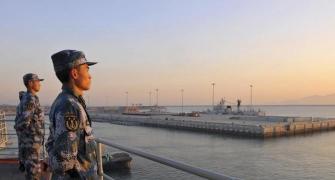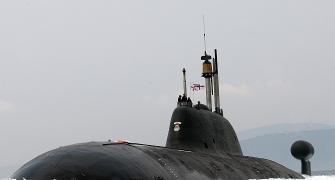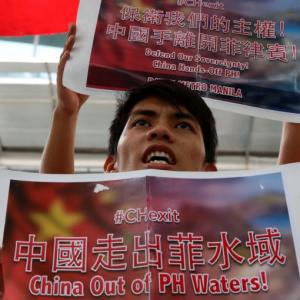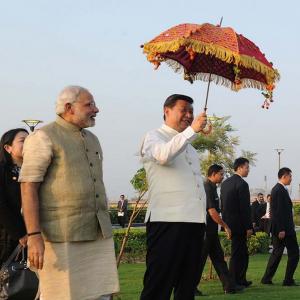'After a strategic pause, Beijing will revive its policy of slowly creeping towards acquiring sovereignty over the South China Sea,' says former RA&W officer Jayadev Ranade.
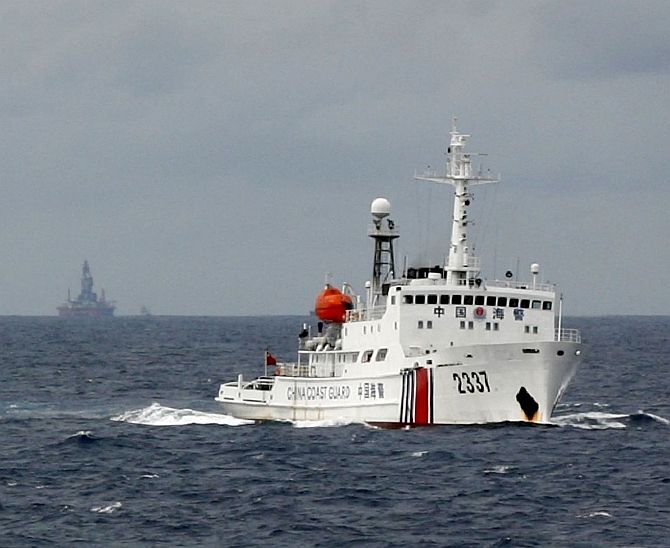
The decision announced by the Permanent Court of Arbitration in The Hague on July 12, 2016, saw a sharp spike in the simmering tension in the South China Sea.
As widely anticipated, the decision favoured The Philippines. The 501-page decision, however, went considerably beyond the issues raised by The Philippines and effectively demolished the arguments advanced by China from time to time including in its White Paper on the South China Sea issued in June 2016 by the Chinese Society of International Law.
The Permanent Court of Arbitration dismissed China's contention that its claims date back to the 2nd century BC and ruled that China has no legal basis for its maritime territorial claims over 3 million square kilometres (or 80%) of the South China Sea nor over its undersea mineral and other resources.
It added, significantly, that the 'nine-dash' line used by Beijing to delineate its South China Sea claims contravenes a United Nations convention on maritime law. China has, however, consistently declined to accept that the Permanent Court of Arbitration has jurisdiction over the issue and its ministry of foreign affairs declared that 'the award is null and void and has no binding force.'
The decision of July 12 is a definite setback to China's assiduous efforts since at least 1974 to build a case for its claims of sovereignty over the South China Sea.
Importantly, including for India, it negates China's bid to cite ancient historical records like 2,000-year-old travellers' accounts and old navigation maps to substantiate its claims, thus additionally implicitly weakening China's other territorial claims.
The decision isolates China and strengthens the maritime territorial claims of other countries like Vietnam, The Philippines, Malaysia and Indonesia. The US, G-7 countries and the 28 EU nations have supported the PCA decision as have Vietnam, Japan and India.
Beijing anticipated the ruling and was prompt to react. Ostensibly to forestall popular protests similar to the anti-Japan demonstrations in 80 Chinese cities four years ago and with an eye to restraining Chinese nationalist sentiment, the 'Beijing Office of the Emergency Committee' promulgated heightened security precautions from the early morning of July 12, 2016.
China's President and Chairman of the Central Military Commission Xi Jinping instructed the People's Liberation Army to 'check all the possibilities' and 'prepare to make war.' The PLA has been placed on 'secondary alert' and the PLA's South Zone, or Southern Theatre Command, the PLA Navy (PLAN)'s South China Sea Fleet, Air Force and Rocket Forces have been placed on 'pre-war status.'
The Strategic Nuclear forces have also been placed on alert. The official Chinese media highlighted that PLAN's South China Sea, East China Sea and North China Sea fleets have been conducting 'live-fire' exercises in the waters near the Xisha Hainan Island from July 8 to 11, 2016, and that PLAN Commander Wu Shengli, PLAN Political Commissar Miao Hua, PLA South Zone Commander Wang Jiaocheng and Deputy Chief of Staff of the CCP Central Military Commission's Joint Staff are witnessing them.
To counter the PCA decision, China orchestrated a diplomatic protest with the Chinese ministry of foreign affairs calling in several Western ambassadors from the night of July 12 till July 13 to convey their complaint against the PCA decision.
Chinese ambassadors in several Western countries similarly telephoned local governments to complain about their country's stances. Chinese Vice Foreign Minister Liu Zhenmin, at a press briefing in Beijing on July 13, questioned the PCA's competence and integrity, saying that its five arbitrators lacked knowledge of 'Asian culture' and were effectively employed by The Philippines.
He asked: 'Can a ruling issued by such an arbitration tribunal have any effect? Does it have credibility? Who would implement a ruling that has no credibility?'
Beijing issued another lengthy 149-paragraph White Paper on the South China Sea on July 13, 2016 where it reiterated its historical claims and sovereignty over the South China Sea, but struck a seemingly conciliatory tone and said it is willing to negotiate with The Philippines.
Chinese Foreign Minister Wang Yi similarly hinted at China's unwillingness to escalate tensions and indicated that China could respond positively to a suggestion for peaceful negotiations made by new Philippines President Rodrigo Duterte on June 30, 2016.
The South China Sea has seen intermittent tension since the 1970s but, as a militarily more powerful Beijing adopted an assertive foreign policy, matters began coming to a head since May 2009 when Beijing submitted a map detailing the 'nine-dash' line to the United Nations.
The following year in July 2010, then US Secretary of State Hillary Clinton declared that the US has a 'national interest' in the South China Sea.
In April 2012, China and The Philippines confronted each other at the Scarborough Reef. The US brokered a withdrawal by both sides, but Chinese ships soon returned to the area and stayed on after Filipino naval vessels had withdrawn.
In January 2013, The Philippines filed a case with the Permanent Court of Arbitration in The Hague, challenging China's claims. Senior Chinese officials warned The Philippines that it would pay a heavy price for at least four years.
After The Philippines approached the PCA, China increased its activities on seven islets in the South China Sea -- namely the Spratlys, Mischief Reef, Subi Reef, Gaven Reef and the Hughes Reef.
China began reclaiming land to enlarge the rock outcrops and small islets and started military-related construction of airfields, communications facilities and gun emplacements.
Satellite photographs revealed this February that China had stationed surface-to-air missiles on WoodyIsland to further extend its 'operational reach.' The objective was to occupy maximum territory before a likely adverse PCA ruling.
The days and weeks ahead will be important for the region. The US, which signed mutual defence pacts with Japan and The Philippines in 1951 and has extensive close ties with China, has little desire for hostilities with China. The economies of the other countries in South East Asia are also dependent on the Chinese economy.
While Beijing will not resile from its claim of sovereignty over most of the South China Sea, it might opt for a long-range strategic view and work towards easing tension.
At the same time Xi Jinping -- who proposed the 'China Dream' with its muscular ambitions, has just rolled out a programme for extensive military reforms and reorganisation, and is preparing for the 19th Party Congress in late 2017 -- cannot afford to appear weak.
It is likely he will opt for a carefully calibrated response which includes Beijing announcing an Air Defence Identification Zone over a part of the South China Sea extending from Hainan to the Spratlys Islands while initiating a dialogue with The Philippines.
Separate negotiations with Vietnam are also a possibility. After a strategic pause though, Beijing will revive its policy of slowly creeping towards acquiring sovereignty over the South China Sea, or 'salami slicing.'
Jayadev Ranade, former Additional Secretary in the Cabinet Secretariat, Government of India, is President of the Centre for China Analysis and Strategy.
IMAGE: A Chinese coast guard vessel and the Chinese oil rig Haiyang Shi You 981 in the South China Sea. Photograph: Reuters

